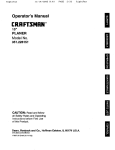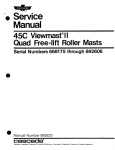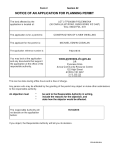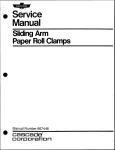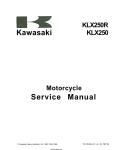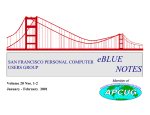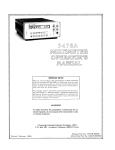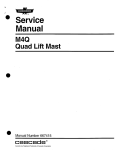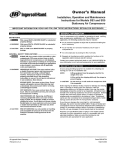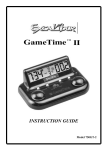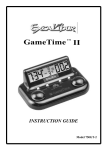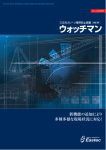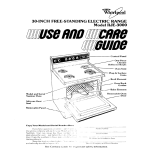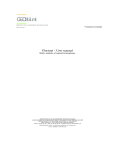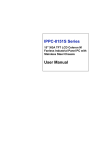Download 667433R1_C- Triple Mast Service Manual
Transcript
Service Manual 30C, 55C, 80C Viewmast® LI Triple Free-lift Roller Masts Serial Numbers 658437 through 692673 Manual Number 667433 Rev. 1 cascade” Cascade is a Registered Trademark of Cascade Corporation l Viewmast is a Registered Trademark of Cascade Corporation I 4 0 Section 1 Introduction This manual provides the installation instructions and maintenance, troubleshooting, and service procedures for the Cascade Viewmast® II a three-stage, full free-lift roller mast. Viewmast® I I provides exceptional visibility for the lift truck driver. The mast carriage and upright channels are all-roller mounted, which results in smooth operation and long service life. A unique, three-stage hoist cylinder provides fast operation NAMEPLATE and uniform lifting and lowering speeds of the carriage. In any communication about your Cascade Viewmast® I, alwavs refer to the mast cataloq and serial numbers stamped on the mast nameplate. If the-nameplate is missing, these numbers are also stamped on the left-hand side plate of the upper crossbar. /’ A WARNING Do not install a Viewmast* I on a truck with a rated capacity than the capacities shown by the accompanying chart. CASCADE VI EWMAST I I greater TRUCK CAPACITY AT 24-INCH LOAD CENTER 30C 3000 Pounds 55C 5500 Pounds 80C 8000 Pounds Rated capacity of the truck/mast combination is a responsibility of the orrginal truck manufacturer and may be less than shown on the mast nameplate. Consult the truck nameplate. 667433 Rev. 1 1 Section 2 InstallationInstructions 2.1 Truck System Requirements To achieve the maximum lifting capacity of the mast, the truck relief valve should be set to relieve at the pressures indicated on the chart below. This chart also indicates the hose and fitting size to use between the truck control valve and the mast bootstrap hose. A WARNING: For proper truck stability or to prevent interference, tilt restriction may be required. Contact the truck manufacturer or one of the Cascade Service Departments listed on the back cover for the specific tilt modification required. Note: To achieve the proper tilt restriction, contact the lift truck manufacturer, or your truck service manual. Cascade Viewmast II Minimum Relief Pressure Maximum Relief Pressure PSI Hose Sizes Fitting Thread Sizes #8 3/4-16 3OC Triple 1650 PSI 2000 55C Triple 1900 PSI 21OOPSI #8 3/4-l 8OC Triple 1800 PSI 2200 #lO 718-14 PSI 6 IMPORTANT: Standard Viewmast® II masts are compatible with SAE 1OW petroleum base oil per Mil. Spec. M IL-O-5606 or MI L-02104 B only. Use of synthetic or aqueous base hydraulic oil is not recommended. If fire resistant hydraulic oil must be used, contact one of the Cascade Service Departments listed on the back cover. 2.2 Mounting Bracket Installation If it is necessary to install mounting brackets and crossmembers to fit your truck, consult with the nearest Cascade Service Department listed on the back cover. You must supply drmensions A through F shown below in Figure 1. Failure to Install the correct brackets and crossmembers can result in mast structural failure, bodily injury and loss of warranty. A WARNING: Failure to install the correct brackets and crossmembers can result in mast structural failure, bodily injury and loss of warranty. TRUCK FRONT Figure 1. Determining 2 Mounting SIDE VIEW VIEW Bracket and Crossmember COWL Location. 667433 Rev.1 , * 0 Section 2 InstallationInstructions 2.2 Mounting Bracket Installation (Cont.) 1. Mounting bracket and crossmember welding must be performed by a qualified welder only, using the following procedures: a. Disassemble the outer channel from the mast prior to welding. See Section 5.3-6 for disassembly procedures b. Clean all surfaces to be welded. Remove paint, oil, grease and other contaminants. c. Locate the mounting brackets and crossmembers mast channels. on the WARNING Clamp in place with a “C” clamp. Protect the mast channel inner surfaces from weld splatter. d. Use only701 8 low hydrogen electrodes AWS E7018, 5/32” diameter. Electrodes must be in good condition. Bake as required to removeall moisture per electrode manufacturers procedures e. Use DC reverse polarity, or an AC welding machine. Set the amperage at 175 amps. f. Preheat the upright and mounting bracets to 100 F. Montior with a Tempstick (crayon). Do not weld in a drafty area. Weld areas that will be vertical seams when the mast is standing upright only. DO NOT WELD ANY HORIZONTAL SEAMS. WARNING: g. Weld areas that will be vertical seams when the mast is standing upright only. DO NOT WELD ANY HORIZONTAL SEAMS. See Figure 2. h. Weld the mounting brackets and crossmember with a .25 in. minimum fillet, holding a close arc. Weld in the flat position only. Do not oscillate or use a wash bead pattern. Make the weld in three passes. Let the weld slow cool. WARNING WELD ON VERTICAL SEAMS ONLY. I. Remove slag and inspect the weld. The following defects are not allowed: undercut, overlap, stress cracks and porosity. Clean the weld area and repaint with Cascade paint part number 668209. Figure 2. Clamp Ground and Weld. 2. The measurement shown in Figure 3 should be taken after welding and cooling the mast. This demenson must be malntalned for the uprrghts to slide together. 3. Reassemble the mast as described TOP VIEW in Section 5.3-8. l-T===3 O”TE/R E 4 UPRIGHT MEASURE INSIDE TO INSIDE OF OUTER UPRIGHT AT TWO PLACES. I Figure 3. 667433 Rev. 1 Dimensional Inspection 3 2 InstallationInstructions Section 2.3 Mast Installation 1. Lubricate mounting 2. the bearing surfaces of the base and tilt cylinder brackets with chassis grease. 7 Lift the mast by a link chain wrapped twice around the upper channel crossmembers. Position the mast into place on the lift truck and secure the base mountings. HOSE GUIDE BOOTSTRAP /HOSE IMPORTANT Prior to connecting the tilt cylinders to the mast, make sure - required to prevent Refer to your truck 3. Connect the tilt the mast from “racking” during service manual for procedures. cylinders to the cylinder anchor HOSE CLAMP tilting. brackets. &OUTER UPRIGHT 4. Before connecting connect the truck actuate the control oil. the truck hose to the mast bootstrap, hose to the truck return fitting and valve to flush the system with hydraulic 5. Connect the lift truck hose to the mast bootstrap hose. See Figure 4. The lift truck hose can be SA.E 100 R2 or R9. NOTE: Use as few fittings as possible and always use 45” elbows instead of 90” elbows. Keep the hose lengths to a minimum. when routing the hose. 2.4 Avoid sharp bends or pinch LIFT TRUCK . HOSE (FROM TRUCK CONTROL VALVE) a- points Figure 4. Cylinder and Truck Hose Connection Operational Inspection and Adjustments CAUTION The factory set adjustments may not be correct for your truck. Check each of the following before using the mast for the first time. q Bleed air from Section 5.1-7. cylinder shell. 0 The hoist cylinder Section 5.1-8. 0 Inspect the chains and check chain tension in Section 5.4-l. q Check crosshead rollers for described in Section 5.1-9. 0 Inspect tracking the cylinder hose for correct tension and over the rollers. Refer to Section 5.3-13. Inspect the bootstrap 0 the mast cylinder Do not use bleed must as described in screw on side of sequence as described proper hose for correct in as described adjustment tracking as in the hose guides. Adjustments to the hose are made by loosening the hose clamp shown in Figure 4. It may be necessary to loosen the connector fitting between the lift truck hose and bootstrap out the hoses. hose to straighten 667433 Rev. 1 . Section 3 Periodic Maintenance For proper operation and an extended service life, your Viewmast® II should be inspected and serviced regularly as part of your normal lift truck maintenance schedule according to the following outlines. conditions or very corrosive atmospheres, should be performed more frequently. A The recommended inspection intervals are for masts operating under normal conditions. If the mast is operating in severe these operations WARNING: Never work on the mast with a load on the forks orattachmentorwhileanyone is nearthe lift truck control handles. Daily Inspection 3.1 Perform the following at the beginning of each work shift: 1 Extend the carriaqe a few inches off the qround and make sure the carriage-chains are under equartension. Refer to Section 5.4-l. Extend themasttoitsfull heighttomakesurethe hoistcylinder sequences properly.The primary plunger should extend fully, then the master and slave plungers should extend together. Make sure the mast channels and carriage extend freely without binding. Refer to Section 5.1-8. Cl Lower the mast and make sure the cylinder sequences properly. The master and slave plungers should lower first, then the primary plunger should lower. Make sure the mast channels and carriage lower freely without binding. Refer to Section 5.1-3. ’ While the mast is extended, inspect the upright channels for proper lubrication. Refer to Section 5.3-8 step 1. q With the mast extended, make sure the hoist chains are under equal tension. Refer to Section 5.4-l. q Make sure the cylinder hose is not twisted and is traveling smoothly in the hose guides. Check the hose to besure it is not scuffing. Minor adjustments to the hose can be made by loosening the hose clampandtwisting the hoseslightlytofit in the guides. Be sure the urethane cushions at the base of the outer and intermediate channels are not flattened or distorted. Check crosshead roller clearance to assure proper operation without binding. Refer to Section 5.1-9. 100 Hour Inspection 3.2 After each 100 hours of lift truck operation, in addition to the daily Inspection: 0 Inspect and lubricate the full length of each pair of hoist chains with SAE 40 oil. CAUTION: The chains must be coated with a film of lubricant at all times. Zl Check each pair of hoist chains for wear and stretch. Refer to Section 5.4. 3.3 500 Hour Inspection After each 500 hours of lift truck operation. in addrtron to thedally and 100 hour Inspection: 0 Check the clearances for load rollers. Refer to Section 5.3-l 2. 667433 Rev. 1 5 Section 4 Troubleshooting The following table lists problems that.may be encountered on your Quad Viewmast® II, the probable causes, and the recommended corrective action that should be taken to restore the mast to normal operating condition. NOTE: Any time oil is added to the truck reservoir, check the hoist cylinder for possible entrapment of air. Refer to Section 5.1-7. SOLUTION PROBLEM CAUSE PROBLEM . Hoist cylinder doesn’t lift load or won’t move- . Empty a) a) Unplug hose or replace Plugged inlet hose b) Insufficient oil b) Check truck hydraulic system for correct oil level in tank, defective pump or pump drive, leaks inthe lines or disconnected control valve linkage. Repairor replace as .-necessary. c) c) Replace defective plungers. Bent or jammed plungers. A WARNING: Extreme care should be used when working on a unit when the carriage (with or without load) is in a raised position. 0 Loaded a) Plugged piston check valve-master may a) Unplug check valve or replace. b) Reversed piston check valve-master may move. b) reverse direction arrow-up. of check valve - c) Truck relief setting low. c) Raise truck relief setting to specified level. Do not exceed: 30C - 2000 psi 55C-2100 psi 80C - 2200 psi d) Over capacity. d) Reduce load to specified capacity. e) Mechanical bind due to bent plunger(s), bad rollers and/or bad cross head rollers. e) Remove mechanical bind by replacing/ freeing plungers and rollers. A WARNING: Extreme care should be used when working on a unit when the carriage (with or without load) is rn a raised position. Mis-sequencing0 Empty or light load Primary up - 1st Slave up - 2nd Master up -3rd, if at all. 0 Loaded Prrmary up-l st Master/Slave2nd Slave stops short of full lift. 6 a) Sequence rod adjusted too long. b) Bent plungers. a) Adjust sequence rod. (Turn clockwise.) b) Repair or replace as necessary. A WARNING: Extreme care should be used when working on a unit when the carriage (with or without load) is in a raised position, c) Master piston ball check not seating properly.(Masterwill moveduring primary staae.) c) Clean and/or replace piston ball check assembly. d) Master piston I.D. O-ring seal leaking. (Master will move during primary stage.) d) Replace C-ring and back-up ring e) Relief valve defective. (Master will move during primary stage.) e) Replace relief valve-do repair. f) Master seal worn out. (Master will move durina onmarv staae.) f) Replace all cylinder seals. 9) Master prston check valve open. 9) Reolace check valve h) Sequence rod out of adjustment. (Too long.) h) Adjust sequence a) Piston sequence valve defective. (Master will move during primary stage.) a) Reparr or replace valve. b) Master prston ball check not seating properly.(Masterwill moveduring primary stage.) b) Clean and/or replace piston ball check assembly. c) Master piston I.D. O-ring seal leaking. (Master will move during primary stage.) c) Replace O-ring and back-up rinq. - not adjust or rod. (Clockwise,) 667433 Rev. 1 Section 4 Troubleshooting ,. PROBLEM 0 Loaded (Continued) SOLUTION PROBLEM CAUSE d) Master seal worn out. (Master will move durina orimaw staae.) d) Replace all cylinder seals. e) Sequence e) Adjust sequence rod. (Turn counter-clockwised rod stroke adjusted too short. f) Repair or replace as necessary. f) Bent plungers. A WARNING: Extreme care should be used when working on a unit when the carriage (with or without load) is in a raised position. 0 Empty or loaded Master up 1st-slow Primary up-2nd (or during) master) Slave up-3rd g) Check valve defective. (Open.) g) Clean or replace as necessary. h) Relief valve defective.(Master times.) h) Replace relief valve. Do not adjust or repair. moves at all a) Relief valve open. a) Replace relief valve - do not adjust or repair. a) External leak in pressure line. a) Tighten or replace as necessary. b) Truck valve defective-cycle height to verifv. b) Repair or replace truck valve. Hoist cylinder driftsl All plungers down to full lift c) External leaks at retainers. c) Replace all cylinder seals. 0 Slave plunger down-Master plunger up. a) Relief valve defective. a) Replace relief valve-do repair. b) Master piston check valve leaking. b) Replace check valve. Master plunger drifts up when load is lifted, then stops. (Approximately 1-2”.) a) Air in cylinder. a) Bleed air from cylinder Spongy or jerky action. a) Air in cylinder. a) Bleed air from cylinder. b) Sticky or defective truck relief valve. b) Remove and check truck relief valve. If contaminated oil caused the malfunctron drain and flush the system, change the filter, and refill with fresh oil. A WARNING: Extreme care should be used when working on a unit when the carriage (with or without load) is in a raised position. c) Bent or damaged cylinder plunger(s). c) Disassemble, assembly. not adjust or check and repair cylrnder A WARNING: Extreme care should be used when working on a unit when the carriage (with or without load) is in a raised posrtron. d) Load rollers Improperly adjusted or defective. - cl) Adjust or repair as necessary. A WARNING: Extreme care should be used when working on a unit when the carriage (with or without load) is in a raised positron. e) Mast channels improperly lubricated. e) Lubricate mast. A WARNING: Extreme care should be used when working on a unit when the carriage (with or without load) is in a raised position. f) Low battery charge. f) Charge battery. g) Low pump volume. g) Install accumulator. h) Low oil level. h) Fill oil reservoir and bleed cylinder, i) Insufficient hydraulic tank capactty or baffles. i) Install larger tanks or baffles. j) j) Adjust sequence improperly k) Other. 667433 Rev. 1 sequencing mast cylinder. rod. k) Contact Cascade Corporation. 7 . Section 5 Service 5.1 Hoist Cylinder 5.1-l Description The hoist cylinder, shown in Figure 6, is a three-stage, displacement cylinder. It consists of a shell with three hollow, telescoping plunger assemblies, The slave plunger (smallest diameter) telescopes into the primary plunger, and the primary plunger telescopes into the master plunger (largest diameter). The shell, master plunger, and primary plunger are threaded at one end to receive retainers. A retainer is threaded into the shell to limit the stroke of the master plunger. A retainer is threaded onto the master plunger which secures an aluminum bearing to limit the stroke of the primary plunger. A retainer is threaded onto the primary plunger which secures an aluminum bearing to limit the stroke of the slave plunger. Each retainer has a Bi-Element seal assembly to provide a high-pressure hydraulic seal between the retainer and its adjacent plunger. In addition, each retainer has a static (nonmoving) O-ring assembly and a plunger wiper. A piston assembly is threaded onto the base of the master plunger. The piston has a Bi-Element seal assembly to provide a high-pressure hydraulic seal between the piston and the cylinder shell. IMPORTANT: During cylinder operation, the pressure produced in the cavity between the cylinder shell and the master plunger is greater than that produced at the cylinder base (truck pressure). Thus, the seal assembly on the master plunger must be installed with the lip piston (item 35, Figure 6) toward the plunger end of the cylinder. spring that bears between the circular plate and the shoulder of a special adjusting nut, threaded onto the upper end of the rod. Access to the adjusting nut can be gained by removing the bleed fitting threaded into a port at the top of the slave plunger. To turn the nut, insert a 3/16-inch, long-handle, Allen wrench. Refer to Section 5.1-8. A lowering control valve is located at the supply port at the base of the cylinder shell. It consists of a spacer, spring, and special washer held in place by an elbow fitting threaded into the port. The lowering control valve is a one-way flow limiter. When the cylinder is extended, oil is free to flow unrestricted around and through the special washer. However, when the cylinder is lowered, the oil flow produced by the retracting plungers forces the special washer toward the spacer. This forces oil to flow through the orifice in the center of the washer (as long as the washer is forced completely against the spacer). This restriction allows the mast to lower at a controlled speed, depending upon the weight of the load. 5.1-2 Bi-Element Seal Assembly (Fig. 13) The hoist cylinder assembly contains four Bi-Element seal assemblies. See Figure 5. Each seal assembly is comprised of a seal element and an anti-extrusion element. The seals are used in combination with nylon back-up rings. The seals mus? be installed in the cylinder assembly with the seal element facing the highest pressure. I The master plunger piston also has a static O-ring seal to seal between the piston and the master plunger. A synthetic bearing is installed on the master plunger piston and cast iron half-rings are installed at the base of the primary and slave plungers. The master plunger piston also serves as a housing for a poppetoperated check valve, a relief valve, and a sequence valve assembly. The sequence valve assembly ensures the proper sequencing of the cylinder plungers during extension and retraction. It is comprised of a spring-loaded ball and seat assembly actuated by a spring-cushioned plunger. The sequence valve plunger is actuated by a rod. The valve plunger is attached to the rod at the rod’s lower end. The rod extends through a square hole in the base of the primary plunger and into the central cavity of the slave plunger and terminates near the top of the slave plunger. A spacer and circular plate are- installed at the top of the sequence valve actuating rod. They are held in place by a ANTI-EXTRUSION ELEMENT SEAL ELEMENT \ \ / HIGHEST PRESSURE INSTALLED Figure 5. Bi-Element NOT INSTALLED Seal Assemblies 667433 Rev. 1 Rod Assy Check Valve Assy. Valve retaining washer (threaded) 39. Bearing O-ring plug 40. Back-up ring 41. Sequence valve plunger nut O-ring 3. Sequence valve plunger 42. Primary plunger retainer 4. Sequence valve plunger spring 43. Seal Relief valve 44. Nylon ring :: Spacer Sequence valve actuating rod 24. 25. Relief valve O-ring Primary plunger wiper 45. 26. Primary plunger half-ring* Bearing 46. 27. Bearing Slave plunger half-ring** i: Nylon ring 47. Back-up ring 9. Lowering control valve spacer 28. Seal O-ring 48. 29. Lowering control valve spring IO. Sequence valve ball plug Slave plunger retainer 49. 11. Lowering control valve washer 30. Sequence valve ball spring 50. Seal 12. Bleed screw 31. Sequence valve ball spacer Nylon ring 51. 13. Bleed screw seal 32. Sequence valve ball Slave plunger wiper 14. O-ring 33. 52. Sequence valve rod plate Bleed fitting 53. 15. Back-up ring 34. Sequence valve rod plate spring Master pi unger piston 54. 16. Master plunger retainer 35. Sequence valve adjusting nut Check valve poppet 55. 17. Seal 36. Adjusting nut cotter pin Check valve 18. Nylon ring 37. Elbow fitting E: Check valve O-ring 19. Master plunger wiper 38. *‘3OC: 4 required with cylinders installed on all masts. l 3OC: 2 required with cylinder installed on 68 and 74-inch masts; 4 required with cylinders installed on 80,86,92,98,104, and **55C: 2 required with cylinders installed on 68,74, and 80-inch masts; 11 11 l-inch masts. 4 required with cylinders installed on 83,92,101,107,114,119, *5X: 2 required with cylinders installed on 68,74,80, and 83-inct I masts; 124,129, and 134-inch masts. 4 required with yclinders installed on 92,101,107,114,119, 124, **SOC: 4 required with cylinders installed on all masts. 129, and 134-inch masts. “8OC: 4 required with cylinders installed on all masts. 21. 22. 23. Master ~luncer Primary plunger Slave plunger Figure 6. Exploded 667433 Rev.1 View of Hoist Cylinder Assembly 9 Section 5 Service 5.1-3 Cylinder Operation (Figure 7) View A The entire cylinder assembly is filled with oil at the beginning of its lifting sequence. Since the cylinder is fully lowered, the check valve is unseated by its actuating poppet in contact with the base of the cylinder shell. Since the sequence valve ball is seated, oil in the cavity between the cylinder shell and the master plunger (referred to as “sequencing oil”) is trapped. The master plunger is thus prevented from moving. As a result, when oil from the truck enters the cylinder through the inlet port, it flows through the angled port in the master plunger piston and through the unseated check valve to the primary and slave plunger cavity. View B Since the area of the primary plunger piston is greater than that of the slave plunger, the primary plunger begins to extend. As the primary plunger reaches the end of its stroke, its base contacts the spacer at the top of the sequence valve actuating rod. Theactuating rod thus shifts upward, pulling the sequence valve plunger upward with it. The sequence valve plunger unseats the sequence valve ball. The point at which this event occurs may be adjusted by turning the special adjusting nut at the top of the sequence valve actuating rod. View C The trapped sequence oil is at a pressure greater than that from the truck. (This pressure intensification results because the area of the piston that forms the cavity between the cylinder shell and the master plunger is less than the area of the base of the master plunger piston. Remember that pressure equals force divided by area. Since the area of the piston in the sequence oil cavity is less, the pressure in the cavity is greater.) Thus, as soon as the sequence valve ball is unseated, the previously trapped high-pressure sequencing oil flows past the unseated sequence valve ball to the primary plunger cavity and seats the unseated check valve. Oil from the truck can thus no longer flow to the plunger cavities and truck pressure begins to extend the master plunger. View D As the master plunger extends, the sequencing oil flows past the unseated sequence valve ball and extends the slave plunger from within the extended primary plunger. This occurs until the cylinder is fully extended, SLAVE PLUNGER, Srnce the volume of the sequencing oil cavity is nearly identical to the volume of the slave plunger cavity, master and slave The volume of oil plungers extend at the same speed. required to lift the master plunger is approximately twice that required to extend the primary plunger (the first plunger to extend), Thus, the master plunger extends at half the speed that the primary plunger extended. However, since the master and slave plungers extend simultaneously at the same speed, the combined speed of the master and slave plungers equals the speed of the primary plunger. As a result, the cylinder assembly extends (and lowers) at a constant speed throughout its complete sequence of operation. MASTER PLUNGER is included in the master A relief valve (shown ln View C) plunger piston. If the pressure of the sequencing oil should exceed a value preset by the relief valve, the valve will unseat to allow pressure to be relieved to the base of the cylinder. This could occur each time the cylinder is extended or when excessive pressure build-up of thesequencing oil, such as would occure when the cylinder is at rest, is heated by ambient air. A check valve is located in the base of the slave plunger piston. The check valvealiows release of trapped oil which could occur is oil leaks past the seal and gets caught between the piston and retainer. The lowering sion. 10 VIEW A of the cylinder assembly is a reversal PRIMARY PLUNGER \ \ \ SEQUENCING 01 L CAVITY \ CYLINDER SHELL CHECK VALVE (UNSEATED) \ SEQUENCE VALVE BALL (SEATED) \ INLET PORT ’ 3 CHECK VALVE’ POPPET of extenlure 7. Hoist Cylinder Sequence of Operation 667433 Rev. 1 Section 5 Service 1 VIEW D SLAVE PLUNGER VIEW C SLAVE PLUNGER \ PRIMARY PLUNGER PRIMARY PLUNGER (FULLY EXTENDED) VIEW B \ SLAVE PLUNGER k/ PRIMARY /PLUNGER MASTER PLUNGER d \ CHECK VALVE (SEATED) MASTER PLUNGER / 0 SEQUENCE VALVI BALL (UNSEATED ,ADJUSTlNG NUT ,SPACER SEQUENCE #‘ACTUATING VALVE ROD SEQUENCE VALVE BALL dUNSEATED CYLINDER -MASTER PLUNGER SEQUENCE /PLUNGER UPWARD) /SEQUENCE / OIL /SHELL VALVE (SHIFTED ,CHECK VALVE (SEATED1 ‘MASTER PLUNGER PISTON SEQUENCE VALVE BALL (UNSEATED) 667433 Rev. 1 MASTEi RELIEF PLUNGER VALVE 11 5 Service Section 5.1-4 Cylinder Removal 1. Make sure the hoist cylinder Iowered. is fully Always lubricate new seals, O-rings, and wipers with petroleum jelly or hydraulic oil prior to installation. CAUTION: SLAVE PLUNGER-/ ( WARNING: RETAINER 2. Loosen the bleed screw no more 1 than required to bleed off any hydraulic pressure that may remain in the cylinder. The bleed screw is located on the side of the cylinder shell just below the large piston re tainer. Tighten the screw securely. UJ 3. Remove the carriage according to the removal procedures specified in Carriage Section 5.2. 4. Remove the pad at the top of the cylinder crosshead. RETAINER TORQUE TO 100-150 FT.-LB. - BACK-UP RING* MASTER PLUNGER 5. Remove the snap ring that retains the crosshead assembly to the hoist cylinder rod. 6. Remove the crosshead. 7. Wash the cylinder assembly with solvent to remove any foreign material on the shell. Especially clean around the plunger retainers. Blow dry with compressed air. If you are going to replace the seals, O-rings, and/or wipers in the plunger retainers only, you can do so with the cylinder in place on the mast according to the following procedures (refer to Figure 8). a. Unthread retainers. the cylinder ( :YLlNDER THREADED WASHER TnRfll .-..--- IF Tn .40-50 FT.-LB. 1 FT.-LB. 55--70 BACK.UP SHELL 5 II I55C & 8OC) L I 17.5-g FT.-LB.] 8. Remove cylinder. CHECK VALVE SEAL* 1 \ RING* / 150-55 INCLUDED IN SERVICE FT.-LB. 1 KIT Figure 8. Hoist Cylinder Components the bootstrap hose from the base of the Be prepared to collect oil. Do not remove the elbow fitting from the cylinder base. To gain access to the hose fitting, you may have to lift the intermediate channel upright high enough to expose the base of the cylinder. Use another lift truck, hoist, crane, or some other suitable lifting device. 12 O-RING* NYLON TO *ITEMS If you are going to replace components in addition to those described above, the cylinder must be removed from the mast. Continue as follows. RING* LO-RING* 1 TORQUE SCREWI <-----J,BACK-UP Do not remove any of plungers. c. Install the retainers as described in section 5. 1-5 steps 12 through 15. Tighten all retainers to the torque values shown in Figure 8. A-BLEED l3OC) and remove all three b. Replace the seals, O-rings, and/or wipers in the retainers as required. Carefully note their positions (see Figure 8). Avoid excessive stretching of the O-ring on the large diameter retainer. LY RING* 9. Cap the fitting at the base of the cylinder with a highpressure steel cap (a plastic cap will not afford sufficient protection to the threads if the fitting is “banged” during cylinder removal). Plug the bootstrap hose. 10. Using a lifting strap and hoist, remove the cylinder the mast. 11. Lay the completely NOTE: collapsed cylinder from on 4 X 4’s. Cut 2 (two) 2” deep U-Cuts in each 4 X 4. 667433 Rev. 1 0 Service Section 5 5.1-5 Cylinder Disassembly, Service and Reassembly 1. Use a claw type spanner wrench to unthread plunger retainer. (Item 16, Figure 6.) the master 2. Slide the master, primary, and slave plungers out of the cylinder shell as an assembly. 3. Remove the seal and nylon ring from the piston at the base of the master plunger using the following procedures. Be careful not to scratch the seal groove diameter. a. Pry the seal up from its groove with a dull screwdriver. b. Cut the seal off the piston groove with wirecutters or a knife. Make sure the knife does not scratch the groove or the plunger. b. Remove the nut retaining the sequence valve plunger and spring. Remove the sequence valve plunger and spring. See Figure 9. c. Depress the sequence valve plug protruding through a hole near the base of the master plunger with a screwdriver or a punch. Then,-using a spanner wrench in the holes provided in the piston, unthread and remove the piston from the plunger. See Figure 10. You may need a helper to hold the plunger with a strap wrench. When you have turned the piston the first 180°, use your screwdriver or punch to prevent the sequence valve plug 1 SCREWDRIVER c. Remove the nylon ring. IMPORTANT When cylinder components are disassembled and seals, O-rings, and wipers are removed, thoroughly wash all metallic parts in solvent. Blow dry with compressed air. Carefully inspect the plungers, cylinder bore, piston, and disassembled valve components. Replace if seriously scored, grooved, pitted, or worn. Minor damage to the cylinder bore and plungers can be removed with 400 grit polishing cloth (wash after polishing). Place components in a clean container until reassembly. 4. Install the new seal and back-up ring on the piston, carefully Avoid excessive noting their position (see Figure 8). stretching of the seal. Using a lubricant such as STP or hydraulic oil will ease seal installation. MASTER PLUNGER WRENCH \STRAP /’ Figure 10. WRENCH Removing the Piston from the Master Plunger 5. Replace the bearing on the piston at the base of the master plunger. from snapping into the hole on the other side of. the plunger. Be prepared to catch the sequence valve plug, spring, spacer, and ball when the plug clears the plunger. 6. Remove the relief valve located on the bottom of the master olunger piston. See Figure 9. It is recommended that the relief valve be replaced. Tighten to a torque of 15-20 ft.-lbs. d. Replace the O-ring and back-up ring on the piston, carefully noting their position. See Figure 8. Avoid excessive stretching of the O-ring during installatron. 7. If vou are aoina - to replace the check valve and/or the 0-rino and back-up ring between the master piston and its plunger, do so now according to the following procedures. If any of these components are not to be replaced, proceed to Step 8. e. If you are not going to replace the check valve, proceed to Step g. a. Remove the O-ring plug from piston. See Figure 9. MASTER the base of the master PLUNGER -4 MASTER PISTON If you are going to replace the check valve, remove the threaded washer retaining the valve. The washer is staked in one place. Remove the valve. (If the poppet behind the valve falls out, it is symmetrical and can be reinstalled either way.) Replace the check valve using a new O-ring. See Figure 11. THREADED WASHER PLUNGER SEQUENCE VALVE PLUNGER SPRING CHECK VALVE ’ +J PISTON POPPET awe 9. Sequence Valve Plunger Assembly and Relict Valve 667433 Rev. 1 13 5 Service Section 5.1-5 Cylinder Disassembly, Reassembly (Cont.) Service and PLACE THE IMPORTANT PISTON IN THE CYLINDER LOADER SHELL. Make sure you install the check valve with the arrow (stamped on the valve body) pointing toward the rod end f. Install and torque the threaded washer to 40-50 ft.-lb. (30C), 65-70 ft.-lb. (55C and 80C). See Figure 8. Stake the washer in place to secure it. NOT ALLOW CYLINDER g. Assemble the sequence valve ball, ball spacer, spring, and plug in place onto the master plunger as shown in Figure 12. Then thread the piston onto the master plunger. As the piston is threaded on, the sequence valve plug will snap into one of the two holes in the plunger. With a LOWER GE OF LOADER TO PISTON BALL SPACER SPRING PLUG igure 12. Sequence Valve Ball Assembly screwdriver or punch, push the plug in and keep turning the piston until it seats. Then back off no more than 1/2 turn until the plug snaps into one of the holes. Use the tools and procedures shown in Figure 10. h. install the sequence valve plunger spring and plunger in the hole in the base of the master piston. See Figure 13. Install and torque the retaining nut to 7.5-9 ft.-lb. &PPLY A THICK FILM 3F PETROLEUM JELLY. Figure 14. 9. Slide the master/primary/slave plunger assembly all the way into the cylinder shell but don’t tighten the large-diameter retainer. See Figure 14. 10. Unthread and remove the upper two retainers, then remove the large-diameter retainer. Do not remove any of the cylinder i. Install the O-ring plug and torque to 50-55 ft.-lb. See Figure 13. Figure 13 illustrates the correct orientation of the sequence valve components when the piston is assembled onto the master plunger. I MASTER PLUNGER --I I PLUG SEQUENCE VALVE PLUNGER SPRING Master Plunger Loader plungers. 11. Replace the seals, o-rings and wipers in the retainers. Lubricate the new seals with petroleum iellv orior to installation Note the correct seal locations. See Figure 8. Avoid excessive stretching of the o-ring on the large-diameter retainer. 12. Place the second largest retainer loader over the end of the master plunger. Apply petroleum jelly to the loader and inner surface of the master plunger retainer. Load the retainer onto the master plunger then remove the loader. Tighten the retainer to a torque of 200-250 ft.-lbs. See Figure 15. ’ BALL SPACER BALL’ MASTER PISTON / PLUNGER Figure 13. Sequence Valve Assembly, Master Plunger Located at the Base of the 8. Place the largest diameter piston loader in See Figure 14. The loader must cover all not contact the thread relief chamfer. The fins can be trimmed with a sharp knife if is needed. The piston will not enter the contacts the thread relief chamfer. Apply the master plunger seals and loader I.D. 14 -. the cylinder shell. of the threads but length of the stop more engagement shell if the loader petroleum jelly to --- . . . 13. Place the third largest retainer loader over the end of primary plunger. Apply petroleum jelly to the loader inner surface of the primary plunger retainer. Load retainer onto the primary plunger. Tighten the retainer torque of 100-150 ft.-lbs. See Figure 15. 667433 the and the to a Rev. 1 , Section 5 Service 5.1-5 Cylinder Disassembly, Reassembly (Cont.) 5.1-7 Service and Bleeding the Cylinder Before the mast is put in service, air must be bled from the hoist cylinder according to the following procedures. 14. Place the smallest retainer loader over the end of the slave plunger. Apply petroleum jelly to the loader and inner surface of the slave plunger retainer. Load the retainer onto the slave plunqer. Tighten the retainer to a torque of I00150 ft.-lbs. See Figure 16. 1. Assemble the forks (or attachment) onto the mast carriage. 2. Without a load on the forks, extend and retract the mast through one complete cycle. 3. With the mast fully lowered, tank and top off if necessary. check the truck hydraulic 4. Extend and retract the mast completely at least four more times. This action will force air in the system to the cylinder center cavity under the bleed fitting. SLA PLUNGER Flgure 16. Retamer 5. Extend the carriage to about 10 inches off the ground. 6. The Customer User Kit (661506) includes a metal hex tube wrench (661507) and a length of clear plastic hose (661922). Slide the plastic hose through the hex tube wrench and onto the bleed fitting located at the top of the cylinder crosshead. Put the other end of the tube in a container to collect oil. See Figure 18. Loader 15. Reinstall the cylinder to the mast by reversing the removal instructions in Section 5.1-4. CLEAR PLASTIC HOSE 661922 . CAUTION: Be sure the cylinder is properly seated in the mast support casting, with the pin in the hole. HEX TUBE ” WRENCH CYLINDER J MAST SUPPORT ICASTING .030” TYP. 5.1-6 Lowering Control Valve Service 1. Remove the hoist cylinder Section 5.1-4. from the mast as specified in 2. Remove the elbow fitting from the base of the hoist cylinder. Be prepared to catch the valve spacer and spring. Remove the lowering control valve special washer. See Figure 17. 3. Clean and inspect the valve components inlet port. Replace any defective parts. 4. Replace the lowering in Figure 17.. control and the cylinder valve components as shown 5. Reinstall the cylinder to the mast by reversing the removal instructions in Section 5.1-4. HOIST TO CONTAINER I I I CYLINDER BASE ,, 1 Figure 18. Hoist Cylinder A Bleed Kit WARNING Stay clear of the carriage ana the forks or attachment. 7. Open the bleed fitting no more than 1/4 turn with the hex tube wrench. The weight of the carriage will force air and hydraulic oil out of the cylinder through the bleed fitting. 8. If the carriage reaches the bottom of its travel before all the air is bled, close the bleed fitting and repeat Steps 5 through 7. SPECIAL 9. When the oil stream no longer contains air bubbles, close the bleed fitting and torque to 25-27 ft.-lb. 10.Top ’ Figure 17. 667433 ELBOW FITTING Lowering Control Valve Assembly Rev. 1 off the truck hydraulic tank with clean, fresh oil. 11. Extend and retract the mast completely. If the mast doesn’t operate smoothly or if it appears to be “spongy”, repeat Steps 2 through 10. 15 Section . 5 Service 5.1-8 + Cylinder Sequencing CROSSHEAD When the mast is actuated from the fully lowered position, the primary plunger should extend from within the master plunger to the end of its stroke. Then the master and slave plungers should extend simultaneously to the end of their See Figure 19. The lowering of the plungers is a strokes. reversal of extension. However, following if adjustment procedures. A is required, do so according 1 1 BOTTOMS the forks or attachment, or while anyone is near the lift truck control handles. Figure 20. I 1.v J Turning the Adjusting Nut Counterclockwise 5. Operate the cylinder with about a half-capacity load to check for proper sequencing. If the slave plunger extends too fast and the master plunger does not extend at all, the sequence valve is not opening. Turn the adjusting nut clockwise one turn only. Reinstall the bleed fitting and retest. Continue this process until the cylinder sequences properly. See Figure 19. The adjusting nut should be turned 10 turns maximum. SLAVE PLUNGER k- MASTER PLUNGER 6. As soon as the cylinder sequences properly, turn the adjusting nut clockwise one more turn only to assure a positive adjustment. CYLINDER /SHELL 7. Extend and retract the cylinder completely. If it does not operate smoothly or if it appears to be “spongy”, bleed air from the cylinder as specified in Section 5.1-7. :I- 5.1-9 Sequence of Hoist Cylinder Plunger Extension The sequencing of the hoist cylinder is controlled by an interna’ sequence valve. The sequence valve is preset at the factory and should not require adjustment. However, if the cylinder IS disassembled, the sequence valve can be adjusted according to the following procedures. 1. Remove the bleed fitting at the top of the slave plunger. 2. Insert a 3/l 6-inch, long-handle, hex socket wrench 662611 into the bleed hole and engage the adjusting nut. 3. Turn the adjusting nut counterclockwise until it bottoms. The nut is crimped slightly to prevent free-turning so it may be a little stiff. Don’t force the nut after it bottoms. See Figure 20. ,MAST 1 1 4. Turn the adjusting nut clockwise two full turns to provide an initial adjustment. Remove the wrench and install the bleed fitting. PRIMARY PLUNGER I WRENCH to the WARNING Never work on the hoist cylinder with a load on THE PRIMARY PLUNGER SHOULD EXTEND FIRST, THEN THE MASTER AND SLAVE PLUNGERS Figure 19. HEX SOCKET Crosshead Adjustment The sum total clearance between the tire shoulders and the Mast I-Beam must be .060” as shown in Figure 21. If one tire is touching the I-Beam (which is acceptable) the other tire should have .060” clearance. Adjust the Crosshead to attain the clearance 1. Loosen the setscrew. See Figure 21. as follows. 2. Use an open end wrench to turn the hex nut to attain the clearance shown in Figure 21. 3. Tighten the setscrew. CAUTION Insufficient tightening can result in the tire loosening the crosshead jamming between the I-Beams. MAST I-BEAM FLANGE I-BEAM FLANGE and I \ A + B = .060” UIDE SETSCREW CAUTION: Figure 21. 16 The tire should never touch the guide at these points. Triple Lift Crosshead Adjustment 667433 Rev. 1 . Section 0 5.2 5 Service Carriage 5.1-1 Description 5.2-2 The carriage, shown in Figure 22, is the structure to which hook-type forks or the attachment is attached. The carriage travels within the channels of the mast inner upright on six, shim-adjustable load rollers. The two upper load rollers are secured to their stub shafts by keepers; the four lower load rollers are held in place by the inner channel when the carriage is assembled onto the mast. All six load rollers are interchangeable. A pair of non-adjustable chain anchors are used to connect the carriage chains to the carriage. /CARRIAGE Carriage Removal The carriage may be removed with the mast installed on ‘the truck according to the following procedures. 1. Block the carriage off the ground and lower the mast to slacken the carriage chains. Connect a sling to the carriage and secure it with some suitable lifting device. 2. Remove the snap rings that retain the chain anchors to the carriage lower fork bar. Remove the chain anchors. WELDMENT NOTE: Stub shafts are replaceable per Technical Bulletin 126. ROLLER SHIM (QTY. AS REQUIRED) ROLLER (6 REQUIRED) KEEPER SHIM KEEPER / / (QTY. AS REQUIRED) (2 REQUIRED) CAPSCREW (4 REQ’D.) (2 REQ’D.) CARRIAGE HOIST CHAIN lure zz. 667433 The Carriage Rev. 1 Assembly 17 5 Service Section 5.2-2 Carriage Removal (Cont.) 3. Back out the two carriage stop screw assemblies. A stop screw assembly is comprised of a nut welded to a sockethead capscrew. See Figure 23. By backing out the nut that extends through the carriage side plate, the socket head of the screw will clear the stop block on the inner channel up right. You may have to extend the carriage to gain access to the stop screw assemblies. 4. Power the hoist cylinder to extend until the inner upright channel clears the carriage load rollers. Back the truck away from the carriage. (If the hoist cylinder is inoperative, raise the inner uoriaht channel with a hoist. crane, or some other suitable lifting device.) l Check strands l Check for show signs anchors,or If wear is l Check for worn, Replace or adjust 5.2-4 I, CARRIAGE SIDE PLATE for protruding of chains. or turned pins. Replace both chain side wear. If pins and outside plates of wear, check for misalignment of sheaves, other components. Correct the misalignment. excessive, replace both strands of chains. broken, or as required. misaligned chain anchors. Carriage Installation (with the mast installed on the truck) Make sure the inner upright channel with chassis lube or Kendall 599474). See Figure 24. members SR-12X are lubricated (Cascade part number STOP BLOCK ION INNER CARRIAGESTOP SCREW ASSEMBLY INNER UPRIGHT CHANNEL -0AD / ROLLER LUBRICATE I-lgore Z3. Carnage Stop Screw Assembly INDICATED BY THE HEAVY LINE 5.2-3 Cleaning and Inspection 3. Inspect the roller bearings by turning the rollers on their shafts. Roller assemblies with roughness or noticeable restrictlons to turning should be replaced. 4. Inspect all welds between the carriage side plates carriage fork bars, If any weld seams are cracked, the carriage. and the replace 6. Inspect the carriage hoist chains. If inspection reveals that one strand of a pair of chains requires replacement, both strands of the pair should be replaced. Check for rust and corrosion. l Check plates, for cracked side plates. If you replace both strands of chains. l Check for tight joints. or corrosion, loosen oil. If they cannot caused by bent pins replace both strands 18 If tight joints find igure 24. cracked 3. With a sling, position blocks in front of the by them with SAE 30 oil or penetrating be loosened or if tight joints are or plates or by peened plate edges, of chains, the carriage mast. assembly in place on 5. Lift the carriage the full length of the inner upright channel and check side play and freedom of movement. Adjust load roller clearance as specified in step 2. 6. Thread Tighten in the carriage stop screw assemblies. to a torque of 100-110 ft.-l bs. CAUTION: can cause side rust (typical) Raise the inner upright sufficiently for the carriage load rollersto be fitted within the inner upright channels. Lower the inner upright over the carriage. 7. Install are caused Mast Lubrication FULL OF EACH 2. Assemble the load rollers onto their stub shafts using an appropriate number of shims. See Figure 22. The shims should be installed to provide a total clearance no looser than 0.030 inch at the tightest point throughout the travel Refer to Section 5.3-12 for load roller of the carriage. shimming. 4. 5. Inspect the stub shafts. If they are damaged or if there are cracks at the base of the stub shafts, the carriage must be replaced or repaired. Refer to Technical Bulletin 126 for stub shaft replacement. l FOR THE LENGTH 1. Remove the load rollers and thoroughly clean the carriage assembly with cleaning solvent. Note the number of shims on the rollers so that an appropriate number of shims can be installed during reassembly. 2. Inspect the rollers for excessive wear or damage. Roller assemblies with visible flat spots or cracks should be replaced. ONLY WHERE 8. Lower Failure to thread in the stop screw assemblies the mast uprights to sequence incorrectly. the carriage the as shown See Figure 41, hoist chains. carriage. and check in paragraph 5.2-5. 9. Check the total freedom scribed in Section 5.3-10, and adjust of the step 7. carriage the load movement 667433 chains as de- Rev. 1 Section 5 Service 5.2-5 Carriage Chain Adjustment The carriage hoist chains should be adjusted so that when the unloaded mast is fully lowered, the carriage is positioned as shown in Figure 25. To adjust the carriage chains: 1. Locate the carriage chain anchors on the inner upright. Figure 26. See CARRIAGECHAIN 2. Adjust one carriage chain anchor nut to achieve the correct carriage position when fully lowered as shown in Figure 25. 3. Adjust the other carriage chain anchor nut to achieve equal chain tension. 5-IN. 3 IN. UNDERCLEARANCE 6-IN. UNDERCLEARANCE, OR UNDERCLEARANCE, A=2 IN A=3 IN CHAIN ANCHOR NUT Figure 25. 5.3 Correct Carriage Positions when Mast is Fully Lowered Figure 26. - - I I Carriage Chain Adjusting Nut Mast Upright Assembly 5.3-1 Upright Description The Cascade Viewmast® II is comprised of three upright assemblies: outer, intermediate, and inner. See Figure 27. 1. Outer Upright Assemblv The outer upright assembly is mounted to the truck. A pair of shim-adjustable load rollers is attached to canted stub shafts located near the top of the upright. A pair of urethane cushions is attached to the lower crossmember to cushion the intermediate upright when the mast is fully lowered. A pair of non-adjustable chain anchors is located near the top of the upright to which the bootstrap hoist chains are attached. 2. Intermediate Upright Assembly The intermediate upright assembly telescopes within the outer upright assembly. A pair of shim-adjustable load rollers is attached to canted stub shafts near the top of the upright and a pair is attached near the bottom of the upright. In addition, a pair of chain sheaves is located near the bottom of the intermediate upright to provide a rolling surface for the bootstrap hoist chain. 667433 Rev. 1 A pair of bushing blocksare bolted to steel blocks welded on both sides of the upright near the bottom. The bushing blocks stabilize the intermediate upright assembly when the mast is extended and tilted back. A cushion is attached to the intermediate upright lower crossmember to cushion the inner upright when the mast is fully lowered. The hoist cylinder rests on a cradle which is integral with the lower crossmember of the intermediate upright assembly. 3. Inner Upright Assemblv The inner upright assembly telescopes within the intermediate upright assembly. A pair of shim-adjustable load rollers is attached to canted stub shafts near the bottom of the assembly. A pair of adjustable chain anchors is located near the bottom of the inner upright assembly to which the bootstrap hoist chains are attached. In addition, a pair of adjustable chain anchors is located on the lower crossmember of the inner upright to which the carriage hoist chains are attached. 4. Mast Operation Figure 28 illustrates the operation of the Cascade Viewmast®lL 19 5 Service Section OUTER NOTE: Upright stub shafts are replaceable per Technical Bulletin 126. INTERMEDIATE INNEk UPRIGHT 1. 2. 3. 4. 5. 6. 7. 8. 9. IO. Figure 27. 20 Exploded Roller (8 required1 Shim Chain anchor block (2 required) Capscrew (4 required) Lockwasher (4 required) Dowel pin (2 required) Chain anchor (4 required) Nut (4 required) Cotter pin (4 required) Pin (6 required) 11. Cotter pin (I 2 required) 12. intermediate upright cushion 13. Capscrew (6 required) 14. Outer upright cushion (2 required) 15. Sheave (2 required) 16. Snap ring (2 required) 17. Bootstrap hoist chain (2 required) 18. Bushing blocks (2 required) 19. Capscrew (2 required) 20. Lockwasher (6 required) View of Mast Upright Assembly 667433 Rev. 1 5 Service Section 0 5.3-1 Upright Description (Cont.) CARRIAGE Iv LIFTING PAD CARRIAGE INTERMEDIATE UPRIGHT CARRIAGE CHAIN OUTER / BOOTSTRAP HOIST CHAIN INTERMEDIATE UPRIGHT CROSSHEAD LIFTING PAD u I I INTERMEDIATE / UPRIGHT SHEAVES A. FULLY LOWERED The carriage chains are anchored to the inner upright. They are looped around the crosshead sheaves and attached to the carriage. The bootstrap chains are anchored to the top of the outer upright. They are looped around the intermediate upright sheaves and attached to the inner upright. The hoist cylinder shell rests on a cradle which is integral with the lower crossmember of the Intermediate upright. B. FREE-LIFT When the hoist cylinder is powered from the fully lowered position, the carriage is drawn upward within the inner upright at a speed twice that of the hoist cylinder. The freelift portion of the extending sequence ends when the crosshead lifting pad contacts the upper crossmember of the inner upright. C. FULLY EXTENDED Continued hoist cylinder extension causes the inner upright and carriage to be drawn upward with the crosshead lifting pad. The extending inner upright also causes the bootstrap chains to draw the intermediate upright and hoist cylinder shell upward. The speed of the extending intermediate upright is half that of the inner upright. Thus phase of mast extension continues until the mast IS fully extended. (The sequencing of the hoist cylinder is independent of mast operation; that is, the master plunger does not necessarily reach the end of its stroke at the end of the free-lift portion of mast extensron. The lowering of the mast is a reversal of extension. Figure 28. 667433 Mast Operation Rev. 1 21 5 Service Section 5.3-2 Crosshead Description The crosshead, shown in Figure 29, is attached to the top of the hoist cylinder. Rollers attached to the crosshead move ‘within guides on the inner upright assembly to guide the hoist cylinder as it extends and retracts. A pair of chain sheaves attached to the crosshead provide a rolling surface for the carriage hoist chains. HOSE GUIDE BOOTSTRAP HOSE CAPSCREW TORQUE TO 6-7 \ FT.-LB. HOSE CLAMP LOCKWASHER _ LIFTING PAD P / SETSCREW / ,’ I NYLON PELLET I I I- OUTER UPRIGHT m \ I iR ---JRkh’lll i CROSSHEAD CHAIN L SHEAVE MARKED Fi gure 30. ROLLER 5.3-3 I ASSEMBLY Crosshead Assembly Mast Removal A WARNING Never work on the mast with a load on the forks or attachment or while anyone is near the lift truck control handles. 1. Make sure the mast is fully lowered. Make sure the mast is straight up (not tilted forward or backward). 2 Rear View of Mast Assembly 6. Disconnect brackets. “OUTSIDE” SNAP RING ’ Figure 29. ‘I-AUXILIARY JUMPER HOSE IBETWEEN TRUCK CONTROL VALVE AND BOOTSTRAP HOSE Remove the forks or attachment from the mast carriage. Remove any auxiliary equipment that would interfere with mast removal. the tilt cylinders from the tilt cylinder 7. Disconnect the mast base mounting anchor brackets. 8. Lift off the mast and set it on a work surface with the carriage up. If the mast is equipped with a hose reel, block under the mast sufficiently to clear the reel, or remove the reel. Make sure the mast assembly does not rest on the bootstrap hose guides. Remove the hose guides if necessary. 5.3-4 Carriage Removal (with mast removed from the truck) 1. Connect a sling to the carriage and secure it with suitable lifting device. some 2. Remove the pins that secure the carriage hoist chains to the chain anchors located on the lower fork bar. See Figure 31, CARRIAGE HOIST CHAI 3. Remove the truck auxiliary hose from the hoist cylinder bootstrap hose. See Figure 30. Be prepared to collect oil. Plug the bootstrap hose and cap the truck auxiliary hose. 4. Loosen the hoist cylinder bteed screw no more than required to bleed off any hydraulic pressure that may remain in the cylinder. The bleed screw is located on the cylinder shell just below the largest piston retainer. Tighten the screw. 5. Wrap a link chain twice (minimum) around the three upper. mast channel crossmembers and secure with a hoist, crane, or some other suitable lifting device. 22 CHAIN ANCHOR ’ COTTER PIN Figure 31. Carriage Hoist Chain Anchor 667433 Rev. 1 . , 5 Service Section 5.3-4 Carriage Removal (Cont.) (with mast removed from the truck) 5.3-6 Upright Disassembly (with mast removed from the truck) Refer to Figure 34. 3. Unthread the two carriage stop screw assemblies. A stop screw assembly is comprised of a nut welded to a socket-. head capscrew. See Figure 32. By backing out the nut that extends through the carriage side plate, the socket head of the screw will clear the stop block on the inner channel upright. Disassembly of the mast uprights with the mast mounted on the truck is NOT recommended. A WARNING: ’ 1. Remove the carriage and hoist cylinder. 5.3-4 and 5.3-5. - Refer to Sections 2. Manually extend the mast until the bootstrap anchor blocks on the inner upright are exposed. 3. Remove the pins that secure the bootstrap the chain anchors on the inner upright. hoist chain hoist chains to 4. Remove the bootstrap chain anchors from the inner upright. STOP BLOCK ION INNER CHANNEL) CARRIAGESTOP SCREW ASSEMBLY lr -I- i INNER UPRIGHT CHANNEL 5. Roll the inner upright toward the top of the mast until the inner upright load rollers are exposed by the cutouts at the top of the intermediate upright. 6. Using a sling and hoist or some other appropriate lifting device, lift the inner upright out of the intermediate upright and set it on a work surface. 7. Roll until outs hoist the intermediate upright toward the top of the mast the intermediate load rollers are exposed by the cutat the top of the outer upright. Pull on the bootstrap chains to keep them straight. CAUTION: Pull on the bootstrap hoist chains to keep them straight. Figure 32. 8. Using a sling and hoist or someother suitable lifting device, lift the intermediate upright out of the outer upright. As soon as the chain sheaves at the bottom of the intermediate upright are clear of the outer upright cutouts, pull the bootstrap hoist chains off the sheaves. ‘See figure 33. Set the intermediate upright on a work surface. Carriage Stop Screw Assembly 4. With the lifting device secured to the carriage, remove the carriage out the bottom of the mast assembly. 9. Remove the bootstrap chain anchors. 5. Remove the carriage hoist chains from the inner upright lower crossmember. hoist chains from the outer upright INTERMEDIATE UPRIGHT 6. For carriage cleaning and inspection, refer to Section 5.2-3. \ 5.3-5 Crosshead and Cylinder Removal (with mast removed from the truck) the bootstrap hose from the base of the hoist Be prepared to collect oil. Do not remove the elbow fitting from the cylinder base. Cap the fitting with a high-pressure steel cap (a plastic cap will not afford sufficient protection to the threads if the fitting is “banged” during cylinder removal). INTERMEDIATE UPRIGHT CHAIN SHEAVE INTERMEDIATE UPRIGHT LOAD ROLLER 1. Remove cylinder. ------ 2. Connect a sling around the hoist cylinder and secure it with some suitable lifting device. 3. Remove .the pad at the top of the cylinder crosshead. 4. Pull the carriage hoist chains through the crosshead sheaves. 5. Remove the snap ring that retains the crosshead assembly to the hoist cylinder rod and remove the crosshead. 6. With the lifting from the mast. device secured to the sling, lift the cylinder 7. For cylinder service, refer to Section 5.1. 667433 Rev.1 OUTER Figure 33. UPRIGHT Bootstrap Hoist Chain Routing 23 Section 5.3-7 5 Service Cleaning and Inspection 1. Remove the load rollers and chain sheaves from the up rights, carriage, and crosshead. Note the number of shims on the rollers so that an appropriate number of shims can be installed during reassembly. 4. Inspect the load rollers and chain sheaves. Roller and sheave assemblies with visible flat spots, excessive wear, or cracks should be replaced. crosshead 5. Inspect the load roller and chain sheave bearings by turning them on a shaft. Roller and sheave assemblies with roughnessor noticeable restrictions to turning should be replaced. 3. Inspect the rolling surfaces of the upright channels. Excessive wear, grooves, or scoring could be the result of faulty load rollers and/or improper mast lubrication. 6. Inspect the rollers on the crosshead. If they do not turn freely or are damaged or excessively worn, replace the roller assemblies. Torclue the roller nut to 30-35 ft.-lbs. 2. Thoroughly clean the upright, assemblies with cleaning solvent. carriage, and HO~STC;~~c~ BOOTSTRAP INTERMEDIATE UPRIGHT INTERMEDIATE UPRIGHT CUTOUT INNER UPRIGHT -ROLLER d.P-iY COTTER PIN ANCHORS COTTER PIN BOOTSTRAP CHAIN ANCHOR Figure 34. 24 667433 Rev. 1 , Section 5.3-7 5 Service Cleaning and inspection (Cont.) 7. Inspect the stub shafts. An assembly with a damaged stub shaft or a cracked stub shaft base should be repaired or replaced. Refer to Technical Bulletin 126 for stub shaft replacement. BUSHING BLOCKS \ INTERMEDIATE UPRIGHT CHAIN ,SHEAVE INTERMEDIATE UPRIGHT \ 8. Inspect the cushions on the lower crossmember of the upright channels. If the cushions are damaged, crushed, or missing, replace them. 9. Inspect the crosshead lifting pad. If it is damaged or crushed, replace it. 10. Inspect the bootstrap hoist chains. Refer to Section 5.4-1. 5.3-8 Upright Reassembly (with uprights lying horizontal) 1. Lubricate the full length of each upright channel with chassis lube or Kendall SR-12X (Cascade part no. 599474) as shown in Figure 35. 2. Assemble the upright load rollers onto their stub shafts using an appropriate number of shims. See Fiugre 34. These shims should be installed to provide a clearance no looser than 0.030 inch at the tightest point throughout the travel of the member. Refer to Section 5.3-12 for load roller shimming. I OU-iER Figure 36. UPRIGHT intermediate 3. Assemble the mast chain sheaves on their stub shafts at the base of the intermediate upright. See Figure 34. INNER UPRIGHT UPRIGHTCHANNEL SECTION LOAD ROLLER: I \ Upright Installation CHAIN ANCHOR \ BOOTSTRAP HOIST CHAIN ANCHOR BLOCK I / LUBRICATE ONLY WHERE INDICATED BY THE HEAVY LINE FOR THE FULL LENGTH OF EACH UPRIGHT. Figure 35. Mast Lubrication (tYPical) 4. Connect the bootstrap hoist chains to the outer upright anchors using new cotter pins. 5. Using a sling and hoist or some other appropriate lifting device, position the intermediate upright over the outer upright as shown in Figure 36. 6. Position the bootstrap hoist chains over the intermediate upright sheaves as shown in Figure 36. 7. Lower the intermediate upright onto the outer upright. Hold the hoist chains out the top of the outer upright to keep them straight. Roll the intermediate upright part way down the outer upright. Adjust load roller clearance as specified in Adjustment Section 5.3-12. 8. Using a sling and hoist or some other suitable lifting device, position the inner upright so that the inner upright load rollers fit into the cutouts at the top of the intermediate upright. Lower the inner upright onto the intermediate upright. See Figure 37. 667433 Rev. 1 I OUTER UPRIGHT Figure 37. Inner Upright BOOTSTRAP HOIST CHAIN INTERMEDIATED UPRIGHT Installation 9. Attach the bootstrap hoist chain anchor blocks to the inner upright. Torque to 60-65 ft.-lbs. See Figure 37. 10. Attach the bootstrap hoist chains to their anchors on the inner upright using new cotter pins. 11. Manually retract the upright assembly. Check for side play and freedom of movement. Adjust load roller clearance as specified in the Adjustment Section 5.3-12. 12. The intermediate upright bushing blocks can be adjusted to four positions. See Figure 36. Adjust the bushing blocks to the tightest position that allows free travel of the uprights. Tighten the capscrews to a torque of 35-40 ft.-lbs. 25 5 Service Section 5.3-9 Crosshead and Cylinder Installation (with uprights lying horizontal) 1. Assemble the crosshead chain sheaves in place on the head assembly. See Figure 38. hb\8 CARRIAGE CHAIN ANCHOR ?iJvYlw2 Cross- ;-PIN I II iI ------COTTER PIN CAPSCREW Figure39. Carriage Hoist Chain Installation Assembly [Inner Upright) CROSSHEAD MARKEd “OUTS1 DE” I SNAP Figure38. ROLiER ASSEMBLY RING Crosshead Assembly 2. Connect the carriage hoist chains to the brackets on the inner upright assembly. See Figure 39. 3. Connect a sling around the hoist cylinder with a suitable lifting device. and secure it 4. Position the hoist cylinder in place in the bracket at the base of the intermediate upright. Make sure the elbow fitting at the base of the cylinder fits into the cutout in the cylinder mounting bracket without binding. 5. Position the crosshead assembly in place at the top of the hoist cylinder. Make sure the crosshead rollers fit into their guides on the inner upright channels. 6. Secure the crosshead to the cylinder snap ring. Refer to Figure 38. :: rod using the retaining i. 5: 6. 7. 8. 7. Install the crosshead lifting pad. Refer to Figure 38. 5.3-10 Carriage Installation (with uprights lying horizontal) 1. Assemble the carriage load rollers onto their stub shafts using an appropriate number of shims. See Figure 40. The shims should be installed to provide a clearance no greater _-_ than ,030 inch at the tightest spot throughout Its travel. Refer to Section 5.3-12 for load roller shimming. 2. Make sure the carriage stop screw assemblies are retracted to clear the inner upright stop blocks. See Figure 32. 3. Connect 26 a sling to the carriage. With a suitable lifting 1 1:: 11. Carriage weldment Roller (6 req’di Roller shim (as req’d) Keeper shim (as req’d) Keeper (2 req’d) Capscrew (4 req’d) Chain anchor (2 req’d) Snap ring (2 req’di Pin (2 req’d) Cotter pin (4 raq’d) Carriage hoist chain NOTE: Items (3) and 14) should be removed/replaced equal numbers. Figure 40. in The Carriage Assembly device, position the carriage in place through the bottom the inner upright. of 4. Roll the carriage the full length of the inner upright channel and check side play and freedom of movement. Adjust the load roller clearances as specified in Section 5.3-12. 667433 Rev. 1 L Section 0 5 Service 5.3-l 0 Carriage Installation (Cont.) 5. Thread in the carriage stop screw assemblies. See Figure 41. Torque to 100-110 ft.-lb. PLATE AFTER 8. Lower the carriage. Stand on left end of lower carriage bar. Measure distance between left bottom of carriage bar and Stand on right end of lower carriage bar and ground. measure distance at same point as before. The difference between the two measurements should not exceed 1/4”+ .06. See Figure 43. LEFT SIDE THE INNER UPRIGHT CHANNEL Figure41. LOWER CARRIAGE BAR Carriage Stop Screw Assembly 6. Roll the carriage hoist chains over the crosshead sheaves and connect the chains to the carriage lower fork bar. See Figure 42. CARRIAGE HOIST CHAIN : , ’ igure 43. 5.3-12 MEASURE THIS DISTANCE TWICE Measuring Carriage Looseness Load Roller Shimming Each pair of load rollers on the uprights and carriage should be shimmed so that a total clearance no greater than 0.030 inch occurs at the tightest point throughout the travel of the member. See Figure 44. I Install a pair of load rollers and use an equal number of shims on each side of the assembly (within oneshim). A standard shim (631881) is 0.030 inch thick. CHAIN ANCHOR v I: To check as shown upright. the XXX the clearance, pry between the upright and load roller below so the opposite load roller is tight against the Measure the clearance for the pair of load rollers at shown. Repeat for each pair of rollers PIN Figure 42. Carriage Hoist Chain Anchor 5.3-11 Mast Installation 1. Clean and lubricate cylinder mounting the bearing surfaces of the base and tilt brackets with wheel bearing grease. 2. Lift the mast by a link chain wrapped three upper channel crossmembers. twice around the 3. Position the mast into place on the lift truck the base mountings. MEASURE CLEARANCE HERE : II and secure 4. Connect the bootstrap hose to the base of the hoist cylinder. If the hose guides were removed during disassembly, install them now. LOAD ROLLERS IRS IMPORTANT Prior to connecting ly. Adjust 5. Connect the brackets. 6. Connect the tilt tilt the truck the tilt cylinders to the cylinders cylinders auxiliary 7. Perform the mast operational described in Section 2.4. 667433 Rev. 1 to as required the tilt to cylinder hose to the bootstrap anchor hose. inspection and adjustments as Measurements typical for each pair of rollers. Figure 44. Roller Clearance 27 , 5 Service Section Hoist Chains 5.4 5.4-1 Inspection and Tension Each pair of hoist chains have been factory-lubricated using heat and pressure to force the lubricant thoroughly into the chain links. Avoid removal or contamination of this factory applied lubricant. Do not wash, sand blast, etch, steam clean, or paint the chains on initial mast installation. Hoist chains must be adjusted wrth equal tension to ensure proper load distribution and mast operation. To determineequal tension, extend the unloaded mast to put the chains under tension. Press the center of a strand of chain with your thumb. Then press at the same place on the other chain of the pair. Each chain in a pair should have equal “give”. Do this with all hoist chains. If they do not have equal tension perform the Mast or Carriage chain adjustment in paragraphs 5.4-3 and 5.4-4. Inspect the hoist chains. If inspection reveals thatone strand of a pair of chains requires replacement, both strands of the pair should be replaced. l Check for rust and corrosion. 0 Check for cracked side plates. If you find cracked side plates, replace both strands of chains. l 0 1. To check the carriage hoist chains, raise the carriage a few inches off the ground to put tension on the chains. 2. To check the mast hoist chains, the mast must be extended sufficiently to expose the chains. If the chains are removed from the mast, you can check chain stretch without using the chain wear scale. lfthe overall length of a hoist chain exceeds 103% of its original length, the chains should be replaced in pairs. The following table provides the length of the hoist chains when new and their limits of stretch. HOIST 0 Check for chain srde wear. If pins and outsrde plates show signs of wear. check for misalignment of sheaves, anchors, or other components. Correct the misalignment, If wear is excessive. replace both strands of chains. 0 Check for worn, broken, or misaligned Replace or adjust as requrred. 5.4-2 chain anchors. 66.3 72.7 79.2 85.6 Chains will If the hoist chains stretch beyond the recommended amount, they should be replaced In pairs. Chain stretch can be measured wrth the chain wear scale 661923 Included with the Customer User Kit. Measure the charns as shown In Figure 45 according to the InstructIons pnnted on the chain wear scale. wrthout a load on the carnage - 80 86 92 98 104 88.1 94.4 100.6 108.1 90.8 97.2 103.6 111.4 111 1 1 II 65.6 71.9 1 55C VIEWMAST® 68 74 107 114 119 124 129 134 63.8 69.8 75.8 78.8 87.8 96.8 102.8 110.3 114.8 119.3 125.3 129.8 68 74 80 87 95 102 112 122 132 142 149 650 71.0 77.0 83.0 91.0 99.0 109.0 119.0 1290 139.0 1470 80 83 92 101 *Chain j 76.9 83.1 894 94.4 100.6 108.1 65.7 71.8 66.8 72.8 78.8 80.3 90.8 98.3 104.3 111.8 116.3 120.8 126.8 1313 78.0 81 .l 90.4 99.7 105.8 113.6 118.2 122.8 129.0 133.6 690 I 73.1 79.3 85.5 93.7 101.9 112.3 122.6 132.9 143.2 151.4 CHAIN 103.6 111.4 68.8 74.9 81 1 82.7 93.5 101.2 107.4 115.1 119.7 124.4 130.6 135.2 II 66.9 71 1 77.3 83.4 91.7 75.0 810 890 970 1030 1130 1250 1350 145.0 99.9 1061 116.4 1510 1555 length ~srfieasured trom holecentertoholecenterofend [‘JEW CHAIN 67.6 74.0 79.2 85.6 92.1 97.2 II 80C VIEWMAST® Measuring Chain Stretch Regular Inspection and lubrication of the hoist Increase their service life and reduce downtime. TABLE 30C VIEWMAST® 64.4 70.6 76.9 83.1 68 74 Check for tight joints. If tight joints are caused by rust or corrosion, loosen them wrth SAE 40 oil or penetrating oil. If they cannot be loosened or if tight joints are caused by bent pins or plates or by peened plate edges, replace both of chains. Check for protruding or turned pins. Replace both strands of chains. CHAIN 1 Length of Length of overal retracted bootstrap 103% limit carriage 103% limit channel length (inches) chain when (inches) chain when I;.. new (inches) new (inches) 128.8 1391 149.4 lmks LENGTH- \ Chain Wear Scale 661923 STRETCHEDCHAIN CARRIAGE CHAIN \ Figure 45. 28 Checking Chain Stretch BOOTSTRAP CHAIN : 667433 Rev. 1 5 Service Section 5.4-3 5.4-4 Mast Chain Adjustment Carriage Chain Adjustment The mast chain should be adjusted so that when the unloaded mast is fully lowered, all upright channels are even with each other at the bottom within 1/8 inch. See Figure 46. The carriage chains should be adjusted so that when the unloaded mast is fully lowered, the carriage is positioned as shown in Figure 48. 1. To adjust, raise the mast until the mast chain adjusting nut is just above the outer upright. See Figures 46 and 47. Tighten or loosen the adjusting nut to adjust one chain to achieve the equal dimension. Adjust the other mast chain until equal tension is achieved. 2. Lower the mast and check your adjustment. All channels should be even with each other at the bottom within l/8 inch. To adjust the carriage chains: 1. Locate the carriage chain anchors on the inner upright. See Figure 49. 2. Adjust one carriage chain anchor nut to achieve the correct carriage position when fully lowered as shown In Figure 48. 3. Adjust the other carriage chain anchor nut to achieve eaual chain tension. 3 IN. UNDERCLEARANCE 5-IN. 6-IN. r UNDERCLEARANCE, OR UNDERCLEARANCE, 7 A=2 IN. A=3 IN. INNER UPRIGHT INTERMEDIATE UPRIGHT HOIST CHAIN ADJUSTING NUTS Figure 48. -I Correct Carriage Positions when Mast is Fully Lowered CARRIAGE CHAIN ‘k. EQUAL Figure 46. Triple Lift Adjusting CHAIN ADJUSTING f l/8 inch CHAIN Nuts NUT COTTER PIN Figure 49. Carriage Chain Adjusting Nut CHAIN ANCHOR ‘HOIST CHAIN Figure 47. 667433 Mast Chain Anchor Rev. 1 29 Section 6.1 6 Standard Labor Times Determining Labor Times Standard Labor Time is the average time required to perform each operation described in Section 5 Service. Each Standard Labor Time is identified by the Service Section paragraph number and title that corresponds to that operation. The Standard Labor Times are based on the assumption a qualified serviceman is working on a reasonably clean mast with adequate tools, We realize the actual time required to perform an operation may occasionally be greater than that Isted. especially if a “first time” serviceman lacks the needed tools. or if a bolt is frozen. But considering all factors that can affect the lob. Cascade can only honor warranty labor claims based on these carefully evaluated averages. We strongly urge servicemen to read the applicable Service Sections of the manual before repairs are initiated. If prnblem diagnosis is difficult. call one of the Cascade Service Departments listed on the back cover. To arrive at the total Standard Labor Time for a job, list each operation and add the ttmes. As an example, to replace bushings, your list should look something like this: 5.2-2 5.2-4 Carriage Removal Carriage Installation Total Standard Labor Time (hours) 6.2 2.0 Standard Labor Times Paragraph Number Cylinder Removal (mast mounted on truck) .... Cylinder Retainer Seal Replacement Steps 1-7. ..................................... 5.1-5 CylinderDisassembly,Serviceand Reassembly. Lowering Control Valve Service ................ 5.1-6 Bleeding the Cylinder ......................... 5.1-7 5.1-8 Cylinder Sequencing .......................... 5.1-9 Crosshead Adjustment ........................ 5.2-2 Carnage Removal (mast mounted on truck). ... 5.2-4 Carriage Installation (mast mounted on truck). 5.2-5 Carnage Chain Adjustment .................... 5.3-3 Mast Removal ................................. 5.3-4 Carnage Removal ............................. 5.3-5 Crosshead and Cylrnder Removal ............. 5.3-6 Upright Drsassembly .......................... 5.3-8 Upright Reassembly ........................... 5.3-9 Crosshead and Cylinder lnstallatron ........... 5.3-10 Carnage lnstallatron ........................... 5.1-4 5.1-4 30 1 .o 1.o Times (hours) 1.0 1.0 3.0 0.5 0.3 0.3 0.5 1 .0 1 .0 0.5 1 .0 0.3 0.5 1.5 3.0 0.5 0.3 667433 Rev. 1 l Do you have questions you need answered right now? Call your nearest Cascade Service Department. Cascade Corporation P.O. Box 20187 2201 N.E. 201 st Ave. Portland. OR 97230 Tel.: 503/666-1511 800-227-2233 (Toll Free) Telex: 3060411 Cable: Cascade Ptl Cascade N.V. European Headquarters P.O. Box 50086 1305 AB A/mere-Haven Achterwerf 240 1357 CB Almere-Haven The Netherlands Tel.: 03240-92911 Telex: 40838 case nl Cascade N.V. Benelux Sales and Service P.O. Box 170 1110 AD Diemen Weesperstraat 110 1112 AP Diemen The Netherlands Tel.: 020-906411 Telex: 14495 cast nl Cascade GmbH Klosterhofweg 52 4050 Monchengladbach B.R. Deutchland Tel.: 02166-602091 Telex: 0852812 Cascade Scandinavia Hydraulik A.B. MuskBtaatan 17-(E.8-9) 25255 tielsrngborg Sweden Tel.: 042-151135 Telex.: 72565 caschbg s Cascade France S.A.R.L. 11. rue Jean Charcot Zone lndustrielle Sud B.P. 22 91421 Morangls Cedex France Tel.: 06-9091139 Telex: cascade 690016f Cascade (Iberia) S.A. Nave Ind;stnal I Calle Cromo 99/Nave G Hospitalet de Llobregat (Barcelona) Spain Tkl.: 93-3350567 Telex: 54018 cast e Cascade (UK) Ltd. 15, Orgreave Crescent Dore House Industrial Handsworth ;;;Me; S13 9NQ Tel.: 0742-697524151617 Telex: 547254 cascsh g Cascade Hydraulics Ltd. 7615 Klmbel Street Mlsslssauga. Ontano Canada L5S-1 A8 Tel 4161677-9695 Direct Parts Line 4161677-9686 4161677-9684 re/Ac: 06-968715 Cascade Materials Handling (Aust.) Ply. Ltd. (Incorporated in N.S.W.) P.O. Box 67 Ermington. 2115 N.S.W Australia Tel.. 02-648-2571 Te/Ac: (790)24302 Cable: Cascaus Cascade Materials Handling (Aust.) Pty. Ltd. 44E Wlnterlon Road Clayton. Victona 3168 Australia Tel.: 03-543-4344 Cable Casmel Cascade (Africa) Pty. Ltd. P.O. Box 625 15 Power Street lsando 1600 South Afrrca Tel.: 01 l-36-561 l/2/3/4/5 Te/Ac (960)8-8869 3 Estate Cascade Japan Ltd. 4-1,l -Chome, Shin Senri Hrgashamachi Toyonaka, Osaka 565 Japan Tel.: 06-835-2900 Te/Ac: 781-5287115 Cascade Cable: Cascadecfe. Osaka 0 Cascade 1984 3-84 P/N 667433 R-1 J

































